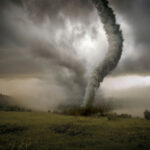Preparing for & Responding to Tornadoes at the Workplace

The tornado season in North America begins in April, peaks in June and July, and ends in September. As residents of Texas and Oklahoma can tell you, this tornado season has started off with a bang as strong storms have already caused extensive devastation, killing dozens, leaving thousands more homeless and destroying businesses. But the storms can occur at any time, with approximately 80 tornadoes reported in Canada and 1,000 in the US each year.
What’s the Danger
Tornadoes can move as fast as 112 km/h and produce winds of more than 400 km/h. They cause many deaths and injuries every year, as well as a great deal of property damage. Because tornadoes can develop very rapidly, it’s vital that people know what to do to reduce the risk to their personal safety and property.
How to Protect Yourself
Some tornadoes occur without a tornado warning. And sometimes the warnings are missed. So it’s important to recognize these signs of a tornado:
- Powerful thunderstorms marked by frequent flashes of lightning;
- Strong rotation in a cloud base;
- Whirling dust or debris on the ground beneath a cloud base;
- Heavy precipitation followed by either calm or an intense wind shift;
- Loud and continuous roar, which, unlike thunder, doesn’t fade in a few seconds; and
- At night, small and bright flashes at ground level instead of in the clouds. These could be power lines being snapped by a strong wind.
What to Do When a Tornado Is Coming
Listen to the radio for tornado warnings during bad thunderstorms. If a tornado warning is issued, don’t panic. Instead, listen and look. Quickly but calmly follow the directions for getting to shelter.
If you have time before the tornado strikes, secure objects such as garbage cans that can injure people. Although most tornado damage is a result of the violent winds, most injuries and deaths actually result from flying debris.
Most importantly, you should:
- Take cover. Go to the basement and crouch down under the stairs. Don’t take an elevator. If you can’t get to a basement, go into a closet, bathroom or other windowless room. Or sit underneath a sturdy piece of furniture on the ground floor near the centre of the building.
- Stay away from windows and outside doors.
- If possible, try to position yourself so that you’re not below heavy objects on the floor above, which could fall through a weakened floor.
- Use a blanket or the like to protect yourself from flying debris. Pull your knees up under you and protect your head with your hands.
- If you’re driving, safely park your car and get to a building. If you can’t get to a building, get away from the car, lie flat and face down in low ground and stay far from other cars or trees.
- If possible, try to avoid being in a building with a wide-span roof, which are vulnerable to collapse in a tornado.
Dealing with the Aftermath
Once the tornado has blown through, the hazards don’t disappear. The US Occupational Safety and Health Administration (OSHA) urged workers and members of the public engaged in cleanup activities after the tornadoes in the south to be aware of the hazards they can encounter and the necessary steps they should take to protect themselves.
Cleanup work can involve various activities, many of which are potentially dangerous and can expose workers to hazards such as:
- Illness from exposure to contaminated water or food;
- Heat stress;
- Downed electrical wires;
- Carbon monoxide and electrical hazards from portable generators;
- Fall and struck-by hazards from tree-trimming or working at heights;
- Unprotected excavations or confined spaces;
- Burns;
- Lacerations;
- Musculoskeletal injuries;
- Being struck by traffic or heavy equipment; and
- Drowning from being caught in moving water or while removing water from flooded structures.
Protective measures should involve:
- Evaluating the work area for all hazards;
- Task-specific hazard exposure monitoring;
- Utilizing engineering or work practice controls to mitigate hazards;
- Using PPE;
- Assuming all power lines are live;
- Following proper hygiene procedures;
- Using portable generators, saws, ladders, vehicles and other equipment correctly; and
- Utilizing traffic work zones.